| 4- The Walls Of Jerusalem Today |  |
|||
| Jerusalem's current walls were built under the orders of Suleiman the Magnificent between the years 1537 and 1541. Some portions were built over the ancient walls from 2,000 years ago. The walls were built to prevent invasions from local tribes and to discourage another crusade by Christians from Europe. They even withstood artillery fire during the war of 1948. The walls of the Old City are 40 feet high and 3.8 km or 2.36 miles around. The Ottoman Turkish sultan had wanted the walls to enclose the southern City of David also, but the architects failed to include Mount Zion or the City of David. As a result, Suleiman had the architects beheaded. There are eight gates in the city walls today: Jaffa Gate, New Gate, Damascus Gate, Herod Gate, Lions Gate, Golden (Eastern) Gate, Dung Gate and Zion Gate. The Old City is divided into four quarters: Armenian, Jewish, Muslim and Christian. The enclosed area is called "The Old City.” The modern city of Jerusalem is much larger and includes a wider variety of business and residential areas than the Old City. | ||||
The graves of the two architects who were responsible for building the wall around Jerusalem. They failed to include Mount Zion which resulted in their decapitation by Suleiman the Magnificent in 1541 AD. |
||||
|
||||
South Wall of Old City Jerusalem |
||||
West Wall of the Old City Jerusalem |
||||
North Wall of the Old City Jerusalem |
||||
| Arrows and bullets were fired from these loopholes, or arrow loops, which are narrow vertical windows in the wall. | ||||
| Looking through an arrow loop from the Temple Mount into the Kidron Valley at a tomb. Notice the road at the base of the Temple Mount Wall that sits above the Kidron Valley. The Mount of Olives is in the background. | ||||
A machicolation, typical of castles and fortifications fo the Middle Ages, where hot oil or rocks were dropped on the invading enemy below. One of the features of medieval warfare was the machicolation—a porch in the wall with openings Josephus records the use of this technique in the following account: |
||||
They (Romans) began already to get upon the wall. Then did Josephus take necessity for his counselor in this utmost distress, and gave orders to pour scalding oil upon those whose shields protected them ...they (Jews) brought being a great quantity also, and poured it on all sides upon the Romans, and they threw down their vessels as they were still hissing from the heat of the fire: this so burnt the Romans, that it dispersed that united band, who now tumbled down from the wall with horrid pains, for the oil did easily run down the whole body from head to foot, under their entire armor, and fed upon their flesh like flame itself. -Josephus, The Great Roman-Jewish War, III.7.27-28 |
||||
| East Wall | North Wall | West Wall | South Wall | Walking on the Walls |
| West Wall (back to top) | ||||
Looking south along the west wall of the Old City from the Citadel. The Hinnom Valley is on the right. |
||||
This is the west wall of the Old City by Jaffa Gate. Jaffa Gate is on the right side of the photo with an opening into the "L" shaped entry just around the corner to the left. |
||||
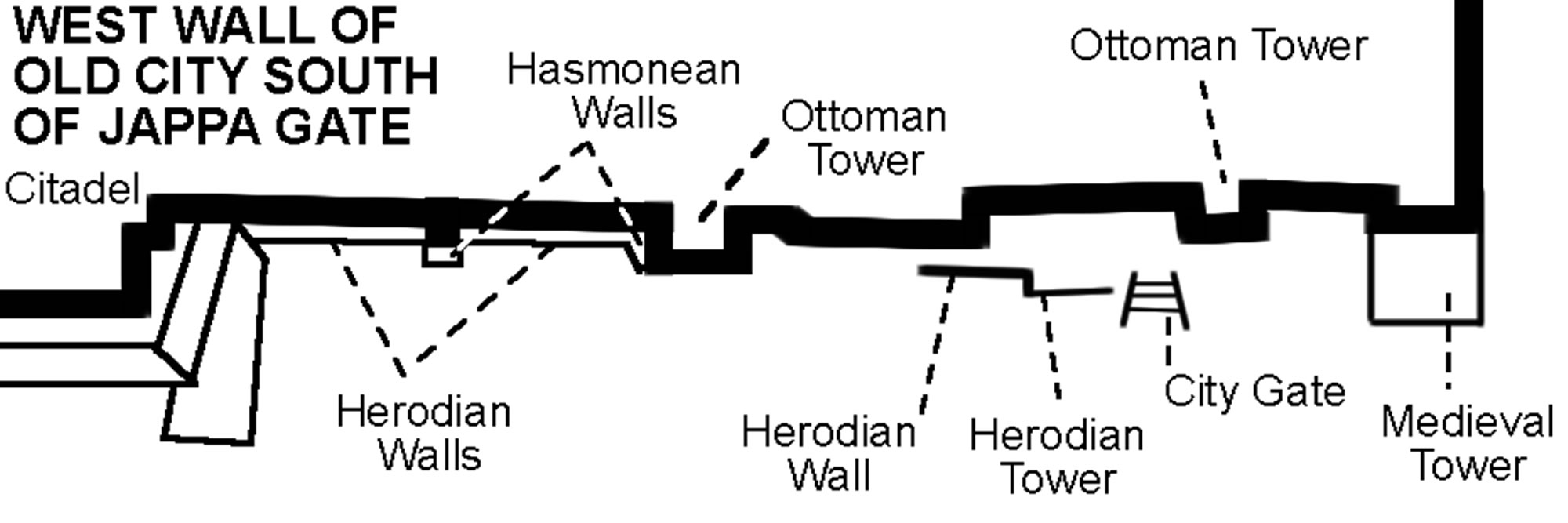 Details of archaeological finds visible along the west wall of the Old City from the Citadel to the southwest corner. |
||||
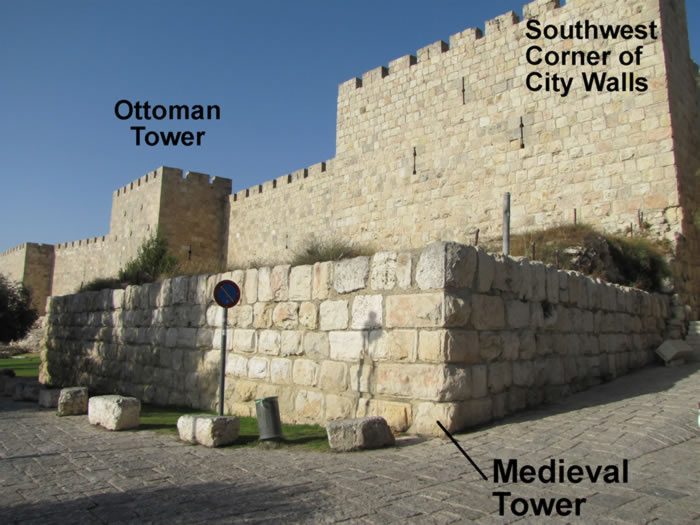 |
||||
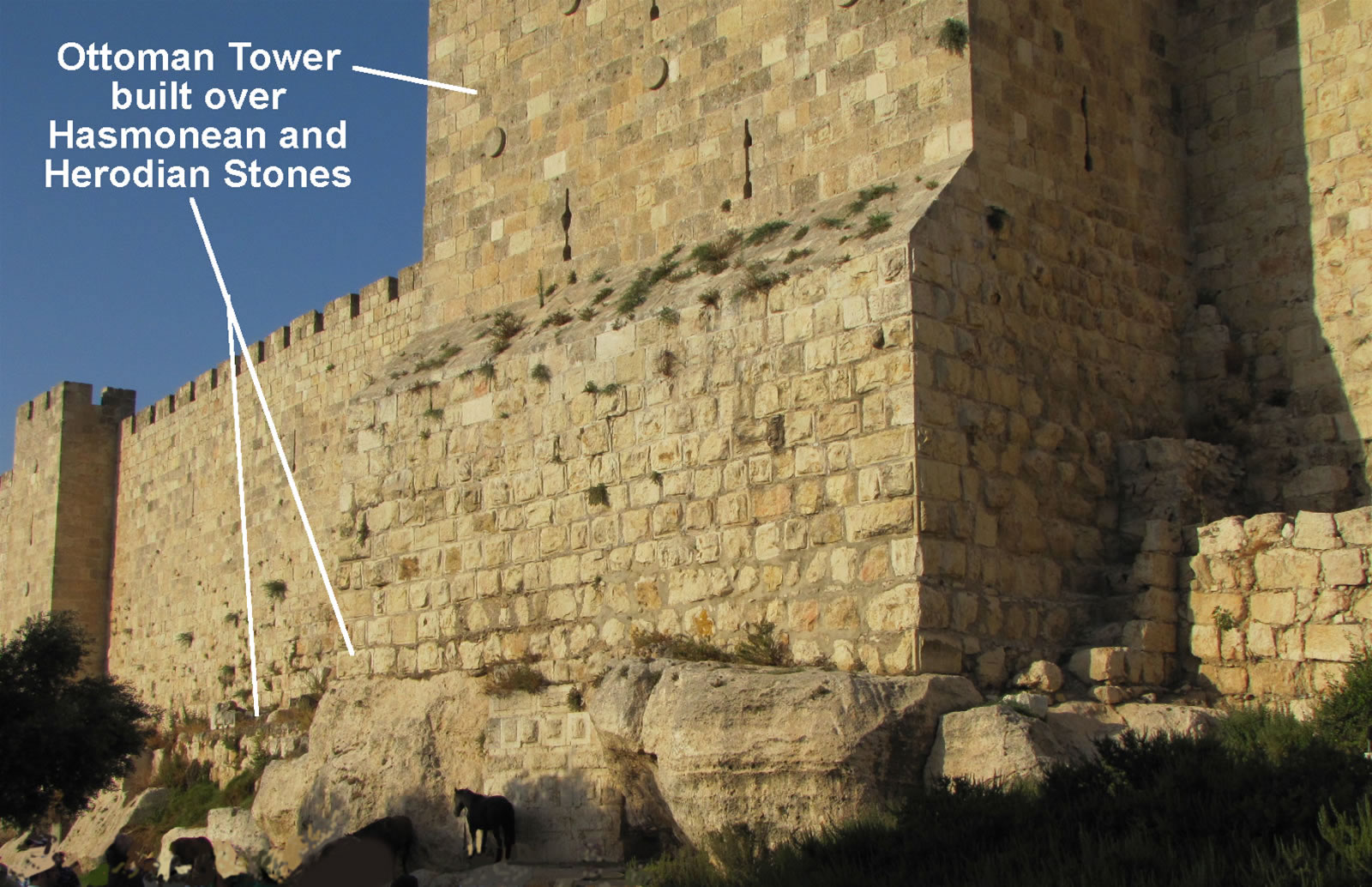 This is a Turkish, or Ottoman, Tower built by Suleiman. Notice the outcropping of the bedrock under the tower. The walls had to be built on solid bedrock and in many places this bedrock can be seen above the service of the ground. Each period that built or rebuilt the walls tended to follow the same wall line on the bedrock. |
||||
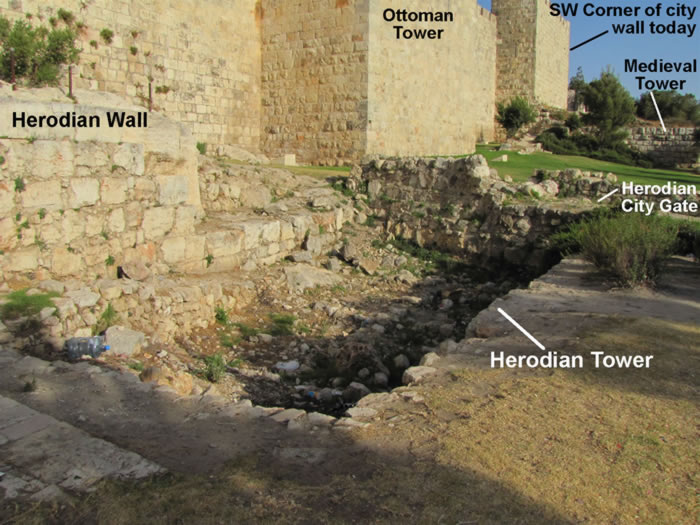 Herod the Great's palace would have stood on the other side of this wall inside the city. Jesus would have been brought here for his trial before Herod Antipas in 30 AD. |
||||
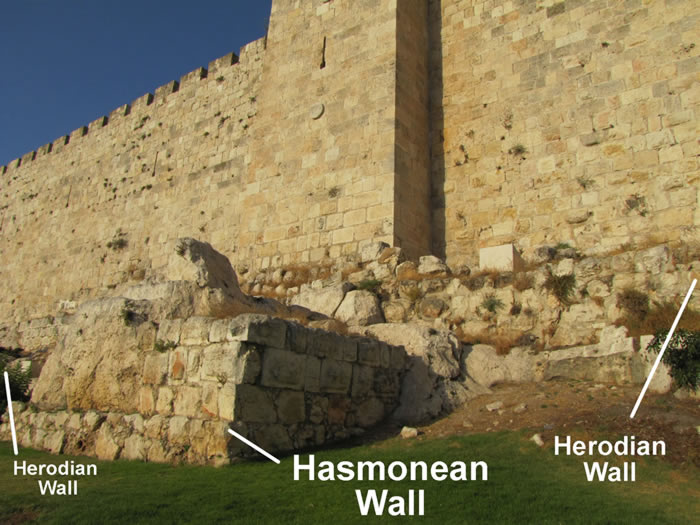 Suleiman's wall from 1535 AD is built along the same line as the Hasmonean (Maccabees’) wall from 160 BC, which was reinforced in the same location by Herod in 20 BC. |
||||
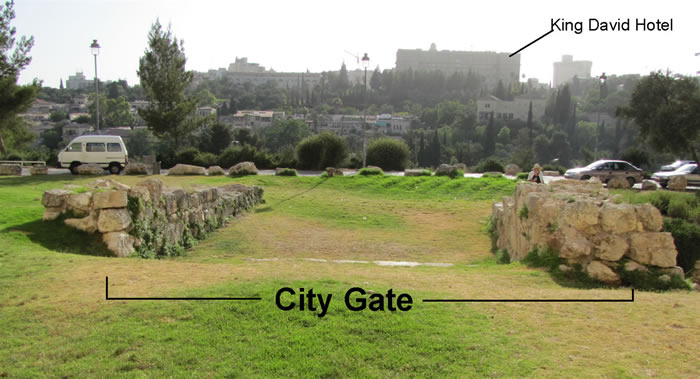 Herodian stones mark a west gate entrance into Herod's city by his palace from 20 BC. The top step of a wide staircase can be seen in the middle of the photo. The steps can be seen when viewed from the other direction. West Jerusalem and the beautiful modern King David Hotel is visible in the distance on the other side of the Hinnom Valley. |
||||
Looking north along the west wall of the Old City which continues northward (but goes out of view for a bit on the left). Two courses of Hasmonean or Herodian stones still sit on the scarp of rock that projects from the bedrock. |
||||
The citadel located just south of the Joppa Gate. The citadel sets inside the west wall of the Old City. |
||||
Toni standing on what remains of a Herodian wall and tower from 20 BC-70 AD located along the west wall of the Old City. Herod's palace would have been located to the right on the inside of the wall. |
||||
| South Wall(back to top) | ||||
This is the south wall of the Old City looking east. The south wall has two gates: Zion Gate and Dung Gate. |
||||
 |
||||
A Herodian Aqueduct remains along the southern wall of the city. |
||||
A Herodian Aqueduct (four courses of rectangular blocks) is filled in with rubble (smaller stones between the four courses of rectangular blocks and the wall of the Old City. Toni is searching higher up on the ancient city wall for interesting remains. |
||||
This is the southeast corner of the Nea Church (2) with the south wall of the Old City built over the top of its previous remains. |
||||
Herodian Residences along the outside of the south wall of the Old City Jerusalem. |
||||
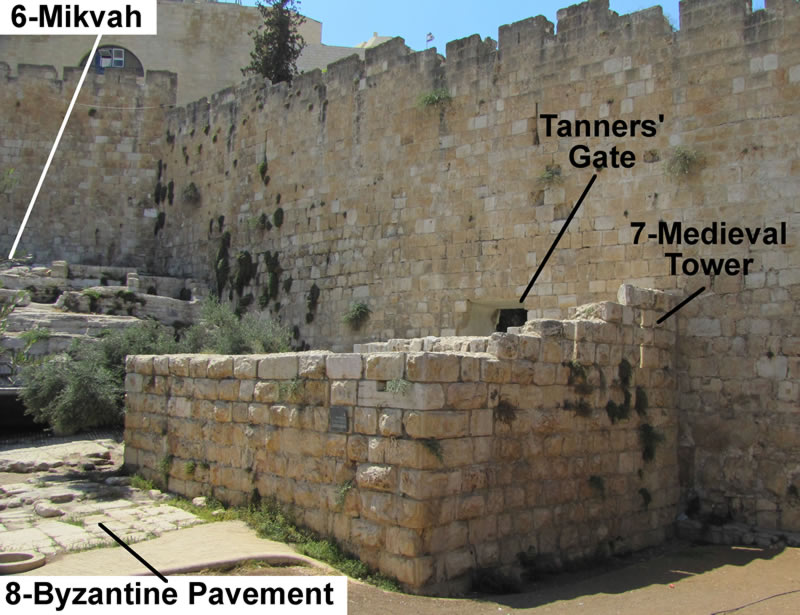 A medieval tower (7) sits by the south wall of the Old City with the Byzantine paving stones still visible. The Dung Gate is to the right (east) of this photo. A medieval tower sits just west of the Dung Gate, east of the mikvah on the south wall. There is a gate called the Tanners’ Postern Gate because the cattle market was located on the inside and provided cow hides for the tanneries outside. The Byzantine street pavement can still be seen. It extends under the wall and continues down to the Pool of Siloam. |
||||
Mikvah's or Jewish ritual bathes from the first century. |
||||
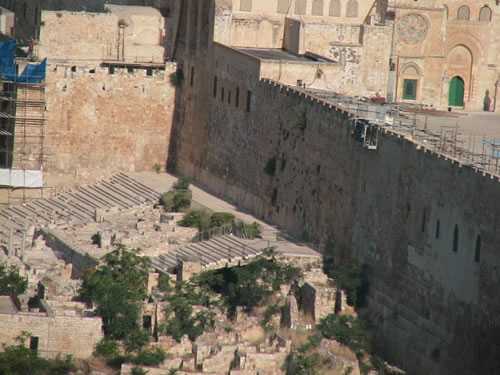 The southern end of the Temple Mount serves as the southeast portion of the Old City's Walls. |
||||
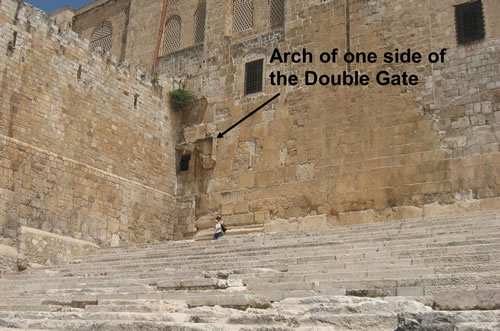 |
||||
North Wall (back to top) |
||||
 Much of the north wall is built on bedrock that extends from the north side of Mount Moriah. |
||||
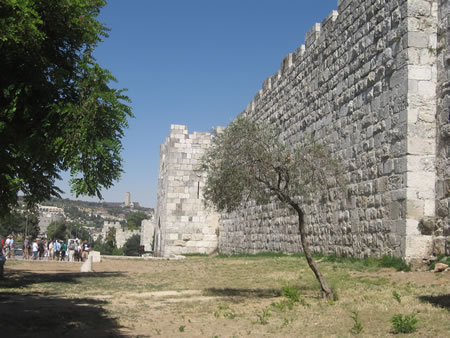 |
||||
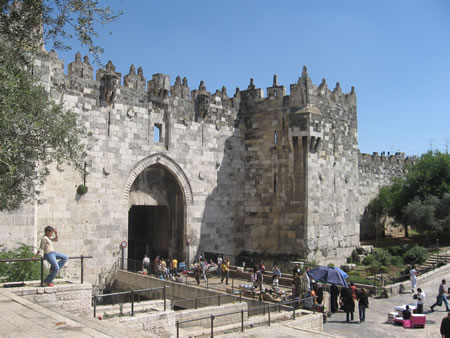 |
||||
A portion of the north wall of the Old City |
||||
The north wall built on the bedrock the extends from Mount Moriah. |
||||
East Wall (back to top) The east wall faces the Kidron Valley and the Mount of Olives. The Eastern Gate (Golden Gate) and the Lion's Gate (Stephen's Gate) are located in the east wall of the Old City. |
||||
The east wall of the Old City contains the Golden Gate and the Lions Gate. This particular gate is the Golden Gate. The Temple Mount sits on the other side of this |
||||
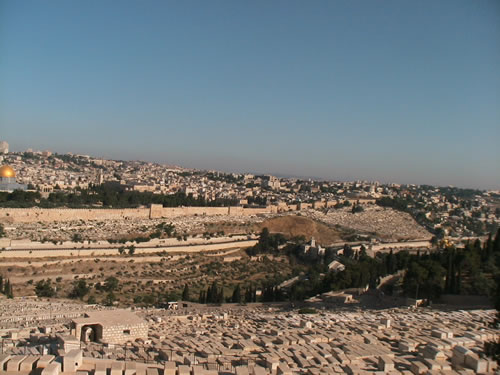 |
||||
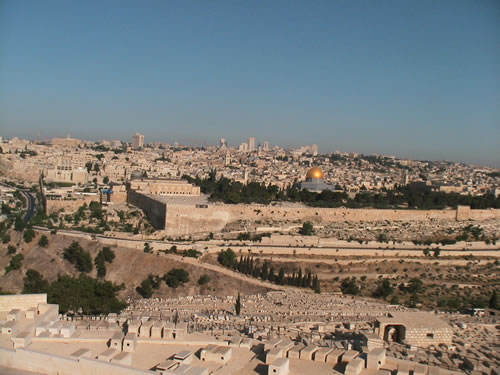 |
||||
 |
||||
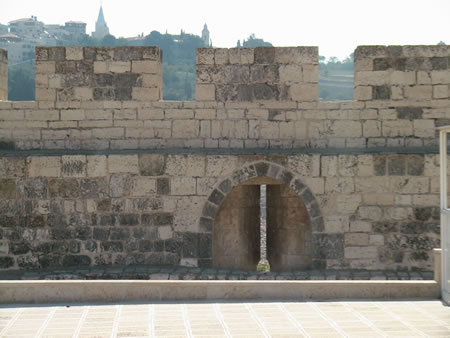 |
||||
 |
||||
 |
||||
| Walking on the Walls (back to top) | ||||
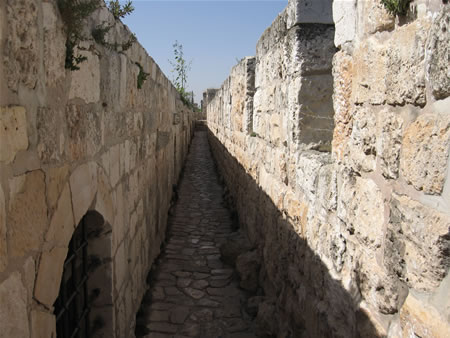 Walking along the top of the walls of the Old City Jerusalem. |
||||
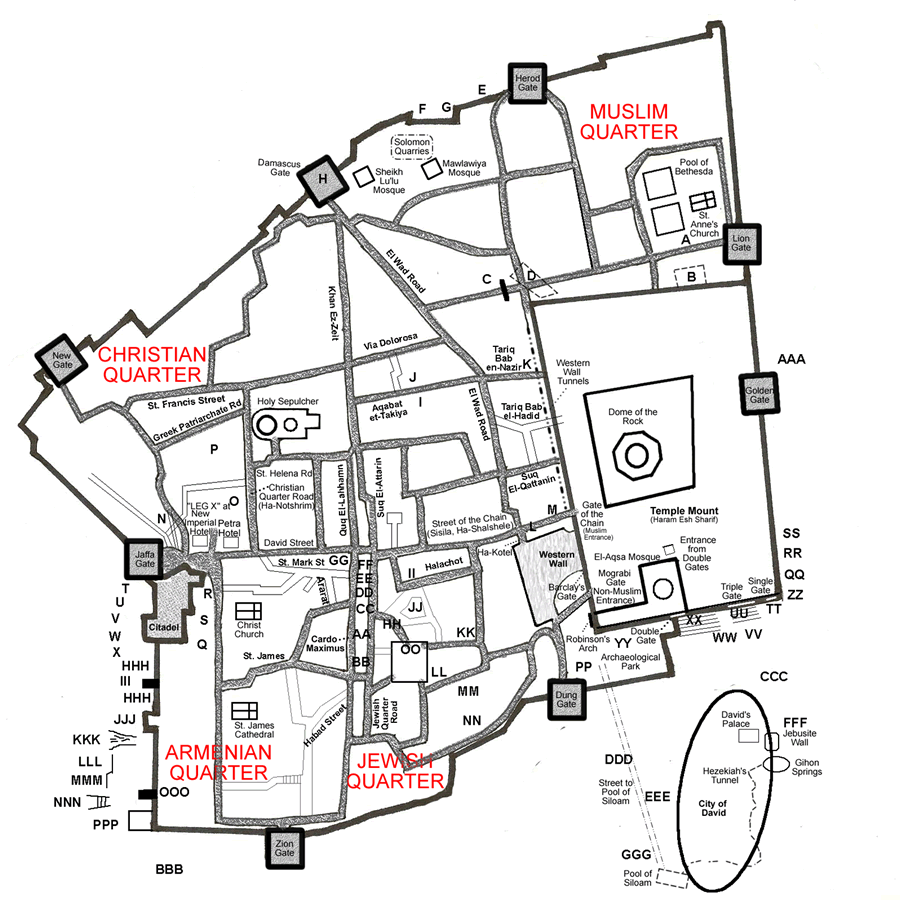 Click HERE (or, on map above) for chart identifying the sites located at the letter markings A through PPP |
||||
| Watch the video - Running around the walls of Jerusalem with Galyn PART ONE. | ||||
| Watch the video - Running around the walls of Jerusalem with Galyn PART TWO. | ||||
| Watch the video - Running around the walls of Jerusalem with Galyn PART THREE. | ||||
| Watch the video - Running around the walls of Jerusalem with Galyn PART FOUR. | ||||
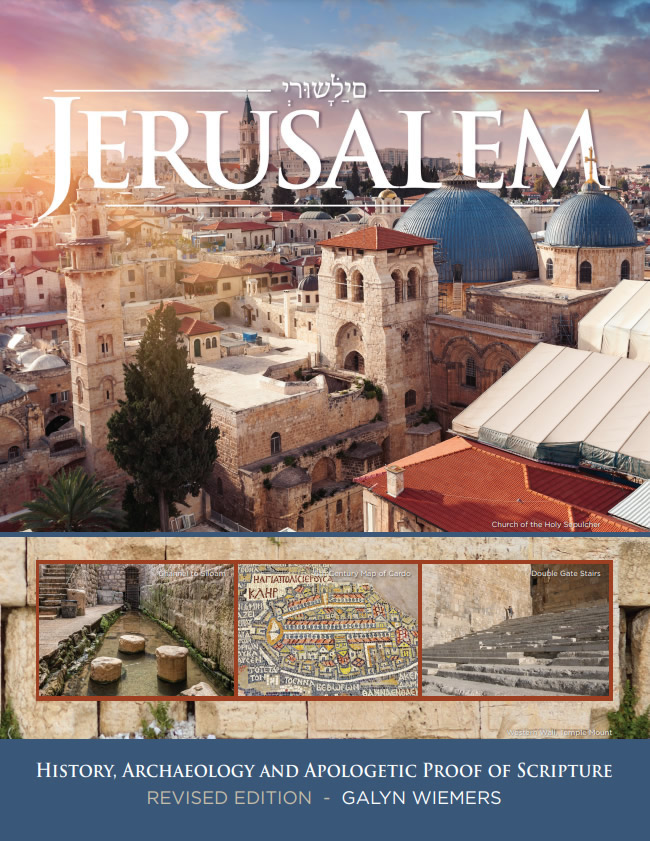 |
UPDATED! 2022 - Open this link |
JERUSALEM: HISTORY, ARCHAEOLOGY AND Download a FREE online .pdf of "Jerusalem" HERE (click on the book cover to download the book as a .pdf ) |
|
|
|
|
|